Main Pathways of Carbon Reduction in Cities under the Target of Carbon Peaking: A Case Study of Nanjing, China
Abstract
1. Introduction
2. Methodology and Data
2.1. LEAP Mode
2.1.1. Calculation of Energy Demand
2.1.2. Calculation of Carbon Emissions
2.2. LMDI Decomposition
2.3. Tapio Decoupling Elasticity Coefficient
2.4. Cross-Elasticity of Pollution Reduction and Carbon Reduction
2.5. Datasets
2.6. Scenario Setting
3. Analysis of Results and Discussion
3.1. Analysis of Total Energy Demand
3.2. Analysis of Total Carbon Emissions
3.3. Analysis of the Factors Influencing the Carbon Peak and the Characteristics of the Carbon Reduction Path
3.3.1. Analysis of the Factors Influencing Carbon Peaking
3.3.2. Decoupling Analysis of Economic Development and Carbon Emissions
3.3.3. Analysis of Emission Reduction Effects of Key Carbon Reduction Measures
3.3.4. Analysis of the Synergy Effect of Key Carbon Reduction Measures
4. Conclusions and Limitations
Author Contributions
Funding
Institutional Review Board Statement
Informed Consent Statement
Data Availability Statement
Conflicts of Interest
References
- Wei, C. Historical trend and drivers of China’s CO2 emissions from 2000 to 2020. Environ. Dev. Sustain. 2022, 75, 1–20. [Google Scholar] [CrossRef] [PubMed]
- Wang, Y.; Yang, H.; Sun, R. Effectiveness of China’s provincial industrial carbon emission reduction and optimization of carbon emission reduction paths in “lagging regions”: Efficiency-cost analysis. J. Environ. Manag. 2020, 275, 111221. [Google Scholar] [CrossRef] [PubMed]
- Cheng, Y.; Gu, B.; Tan, X.; Yan, H.; Sheng, Y. Allocation of provincial carbon emission allowances under China’s 2030 carbon peak target: A dynamic multi-criteria decision analysis method. Sci. Total Environ. 2022, 837, 155798. [Google Scholar] [CrossRef]
- Wu, X.; Xu, C.; Ma, T.; Xu, J.; Zhang, C. Carbon emission of China’s power industry: Driving factors and emission reduction path. Environ. Sci. Pollut. Res. 2022, 29, 78345–78360. [Google Scholar] [CrossRef]
- Xu, T.; Kang, C.; Zhang, H. China’s efforts towards carbon neutrality: Does energy-saving and emission-reduction policy mitigate carbon emissions? J. Environ. Manag. 2022, 316, 115286. [Google Scholar] [CrossRef]
- Chang, W.Y.; Wang, S.; Song, X.; Zhong, F. Economic effects of command-and-control abatement policies under China’s 2030 carbon emission goal. J. Environ. Manag. 2022, 312, 114925. [Google Scholar] [CrossRef]
- Liu, J.; Duan, Y.; Zhong, S. Does green innovation suppress carbon emission intensity? New evidence from China. Environ. Sci. Pollut. Res. 2022, 29, 86722–86743. [Google Scholar] [CrossRef]
- Liu, J.; Bai, J.; Deng, Y.; Chen, X.; Liu, X. Impact of energy structure on carbon emission and economy of China in the scenario of carbon taxation. Sci. Total Environ. 2021, 762, 143093. [Google Scholar] [CrossRef] [PubMed]
- Tang, D.; Zhang, Y.; Bethel, B.J. A comprehensive evaluation of carbon emission reduction capability in the Yangtze River economic belt. Int. J. Environ. Res. Public Health 2020, 17, 545–550. [Google Scholar] [CrossRef]
- Wang, J.J.; Li, Y.; Zhang, Y. Research on carbon emissions of road traffic in Chengdu city based on a LEAP model. Sustainability 2022, 14, 5625–5642. [Google Scholar] [CrossRef]
- Duan, H.Y.; Zhang, S.P.; Duan, S.Y. Carbon emissions peak prediction and the reduction pathway in buildings during operation in Jilin province based on LEAP. Sustainability 2019, 11, 4540–4562. [Google Scholar] [CrossRef]
- Nnaemeka, V.E.; Chinenye, C.E.; Girish, P.M. Energy policy for low carbon development in Nigeria: A LEAP model application. Renew. Sustain. Energy Rev. 2017, 68, 247–261. [Google Scholar] [CrossRef]
- Qu, S.; Yang, H.; Ji, Y. Low-carbon supply chain optimization considering warranty period and carbon emission reduction level under cap-and-trade regulation. Environ. Dev. Sustain. 2021, 23, 18040–18067. [Google Scholar] [CrossRef]
- An, Y.; Zhou, D.; Yu, J.; Shi, X. Carbon emission reduction characteristics for China’s manufacturing firms: Implications for formulating carbon policies. J. Environ. Manag. 2021, 284, 112055. [Google Scholar] [CrossRef] [PubMed]
- Gallaher, M.; Delhotal, K.C. Modeling the impact of technical change on emissions abatement investments in developing countries. J. Technol. Transf. 2004, 30, 211–225. [Google Scholar] [CrossRef]
- Lin, X.; Zhang, Y.; Zou, C.; Peng, L. CO2 emission characteristics and reduction responsibility of industrial subsectors in China. Sci. Total Environ. 2020, 699, 134386. [Google Scholar] [CrossRef]
- Dong, F.; Qin, C.; Zhang, X.; Zhao, X.; Pan, Y. Towards carbon neutrality: The impact of renewable energy development on carbon emission efficiency. Int. J. Environ. Res. 2021, 18, 167–179. [Google Scholar] [CrossRef]
- Li, L.; Ye, F.; Li, Y.; Chang, C.T. How will the Chinese certified emission reduction scheme save cost for the national carbon trading system? J. Environ. Manag. 2019, 244, 99–109. [Google Scholar] [CrossRef]
- Singer, C.E.; Rethinaraj, T.S.G.; Addy, S.; Durham, D. Probability distributions for carbon emissions and atmospheric response. Clim. Chang. 2008, 88, 309–342. [Google Scholar] [CrossRef]
- Jiang, K.; Masui, T.; Morita, T.; Matsuoka, Y. Long-term emission scenarios for China. Environ. Econ. Policy Stud. 1999, 2, 267–287. [Google Scholar] [CrossRef]
- Song, X.; Geng, Y.; Li, K.; Zhang, X.; Wu, F. Does environmental infrastructure investment contribute to emissions reduction? A case of China. Front. Energy 2020, 14, 57–70. [Google Scholar] [CrossRef]
- Liu, Z.; Li, L.; Zhang, Y. Investigating the CO2 emission differences among China’s transport sectors and their influencing factors. Nat. Hazards 2015, 77, 1323–1343. [Google Scholar] [CrossRef]
- National Bureau of Statistics of China. China Energy Statistical Yearbook; China Statistics Press: Beijing, China, 2020; (In Chinese). Available online: https://data.cnki.net/v3/trade/Yearbook/Single/N2022060061?zcode=Z025 (accessed on 3 March 2021).
- Bureau of Statistics of Nanjing. Nanjing Statistical Yearbook, 2020; Nanjing Statistics Press: Nanjing, China, 2020; (In Chinese). Available online: https://www.yearbookchina.com/navibooklist-n3020013098-1.html (accessed on 5 March 2021).
- Bureau of Ecological Environment of Nanjing. Nanjing ‘14th Five-Year’ Air Pollution Prevention and Control Plan; Bureau of Ecological Environment of Nanjing Press: Nanjing, China, 2022; (In Chinese). Available online: https://www.hbzhan.com/news/detail/153021.html (accessed on 6 September 2022).
- State Grid Nanjing Power Supply Company. Nanjing New Electricity System Construction Master Plan (2021–2025); State Grid Nanjing Power Supply Company Press: Nanjing, China, 2022; (In Chinese). Available online: https://wap.yzwb.net/wap/news/1985192.html (accessed on 26 February 2022).
- Nanjing Municipal People’s Government. Nanjing ‘14th Five-Year’ Modern Service Industry Development Plan; Nanjing Municipal People’s Government Press: Nanjing, China, 2021; (In Chinese). Available online: https://www.nanjing.gov.cn/zdgk/202110/t20211018_3160918.html (accessed on 26 September 2021).
- Nanjing Municipal People’s Government. Nanjing ‘14th Five-Year’ Major Infrastructure Construction Plan; Nanjing Municipal People’s Government Press: Nanjing, China, 2021; (In Chinese). Available online: http://www.nanjing.gov.cn/zdgk/202111/t20211118_3199930.html (accessed on 22 September 2021).
- Nanjing Municipal People’s Government. Nanjing ‘14th Five-Year’ Open Economy Development Plan; Nanjing Municipal People’s Government Press: Nanjing, China, 2021; (In Chinese). Available online: http://www.nanjing.gov.cn/zdgk/202203/t20220314_3317374.html (accessed on 17 November 2021).
- Nanjing Municipal People’s Government. Notice of Nanjing Municipal People’s Government on the Issuance of Nanjing’s 13th Five-Year Plan for Controlling Greenhouse Gas Emissions; Nanjing Municipal People’s Government Press: Nanjing, China, 2017; (In Chinese). Available online: https://kjc.jit.edu.cn/info/1017/4883.htm) (accessed on 14 August 2017).
- Izabela, J.K. Towards the reduction of CO2 emissions. Paths of pro-ecological transformation of energy mixes in European countries with an above-average share of coal in energy consumption. Resour. Policy 2022, 77, 102701. [Google Scholar] [CrossRef]
- Wang, F.; Ge, X. Inter-provincial responsibility allocation of carbon emission in China to coordinate regional development. Environ. Sci. Pollut. Res. 2022, 29, 7025–7041. [Google Scholar] [CrossRef] [PubMed]
- Dong, F.; Zhu, J.; Li, Y.; Chen, Y.; Gao, Y. How green technology innovation affects carbon emission efficiency: Evidence from developed countries proposing carbon neutrality targets. Environ. Sci. Pollut. Res. 2022, 29, 35780–35799. [Google Scholar] [CrossRef] [PubMed]
- Yang, Y.; Dong, S.; Li, F. An analysis on the adoption of an interregional carbon emission reduction allocation approach in the context of China’s interprovincial carbon emission transfer. Environ. Dev. Sustain. 2021, 23, 4385–4411. [Google Scholar] [CrossRef]
- Yue, D.; Sarkar, A.; Cui, Y. Ecological compensation of grain trade within urban, rural areas and provinces in China: A prospect of a carbon transfer mechanism. Environ. Dev. Sustain. 2021, 23, 16688–16712. [Google Scholar] [CrossRef]
- Xiao, H.W.; Ma, Z.Y.; Zhang, P.; Liu, M. Study of the impact of energy consumption structure on carbon emission intensity in China from the perspective of spatial effects. Nat. Hazards 2018, 99, 1365–1380. [Google Scholar] [CrossRef]
- Tang, K.; Liu, Y.; Zhou, D.; Qiu, Y. Urban carbon emission intensity under emission trading system in a developing economy: Evidence from 273 Chinese cities. Environ. Sci. Pollut. Res. 2021, 28, 5168–5179. [Google Scholar] [CrossRef]
- Liu, M.L.; Li, Z.H.; Anwar, S.; Zhang, Y. Supply Chain carbon emission reductions and coordination when consumers have a strong preference for low-carbon products. Environ. Sci. Pollut. Res. 2021, 28, 19969–19983. [Google Scholar] [CrossRef]
- Dong, Z.; Chen, W.; Wang, S. Emission reduction target, complexity and industrial performance. J. Environ. Manag. 2020, 260, 110–118. [Google Scholar] [CrossRef] [PubMed]
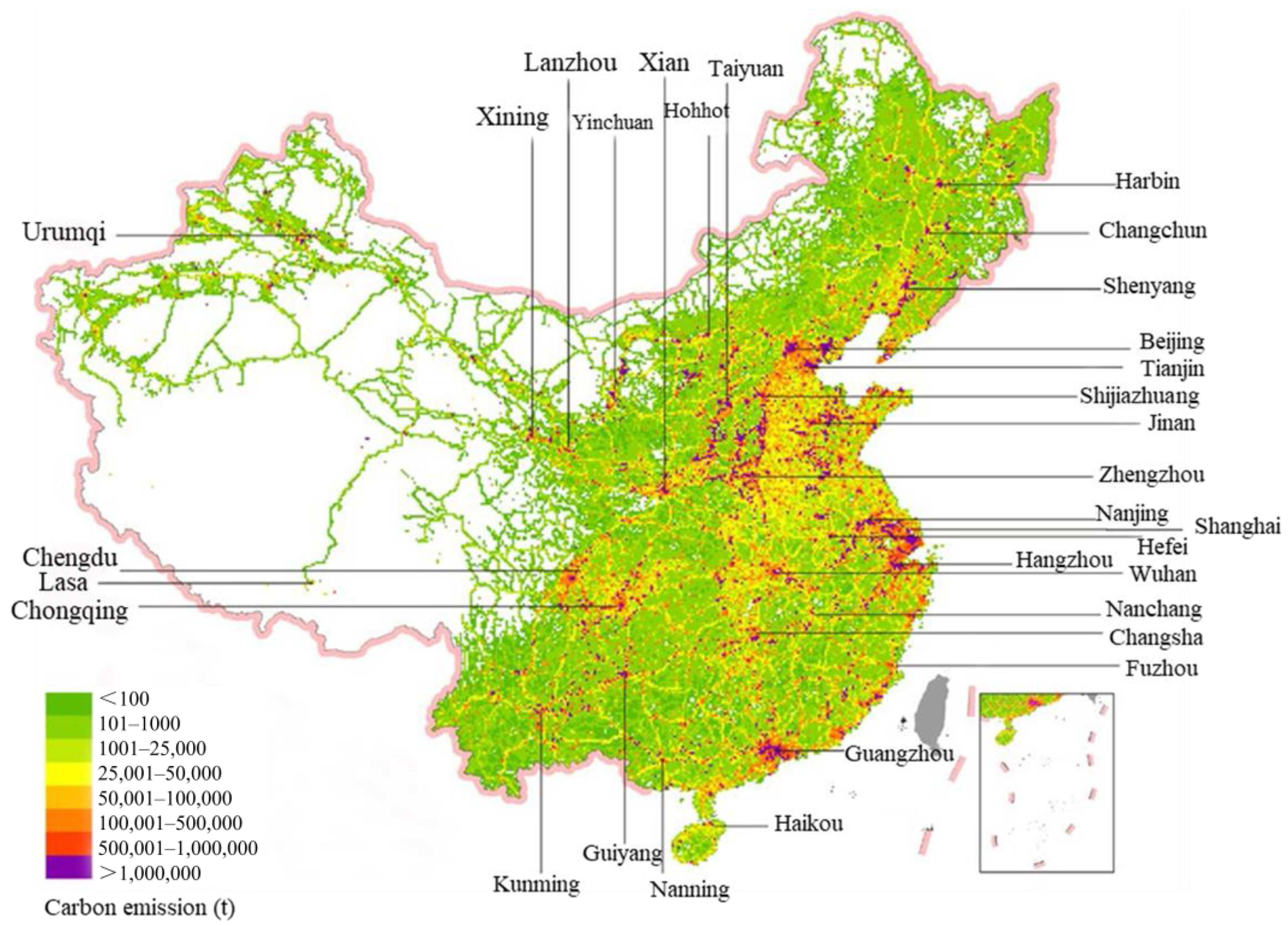
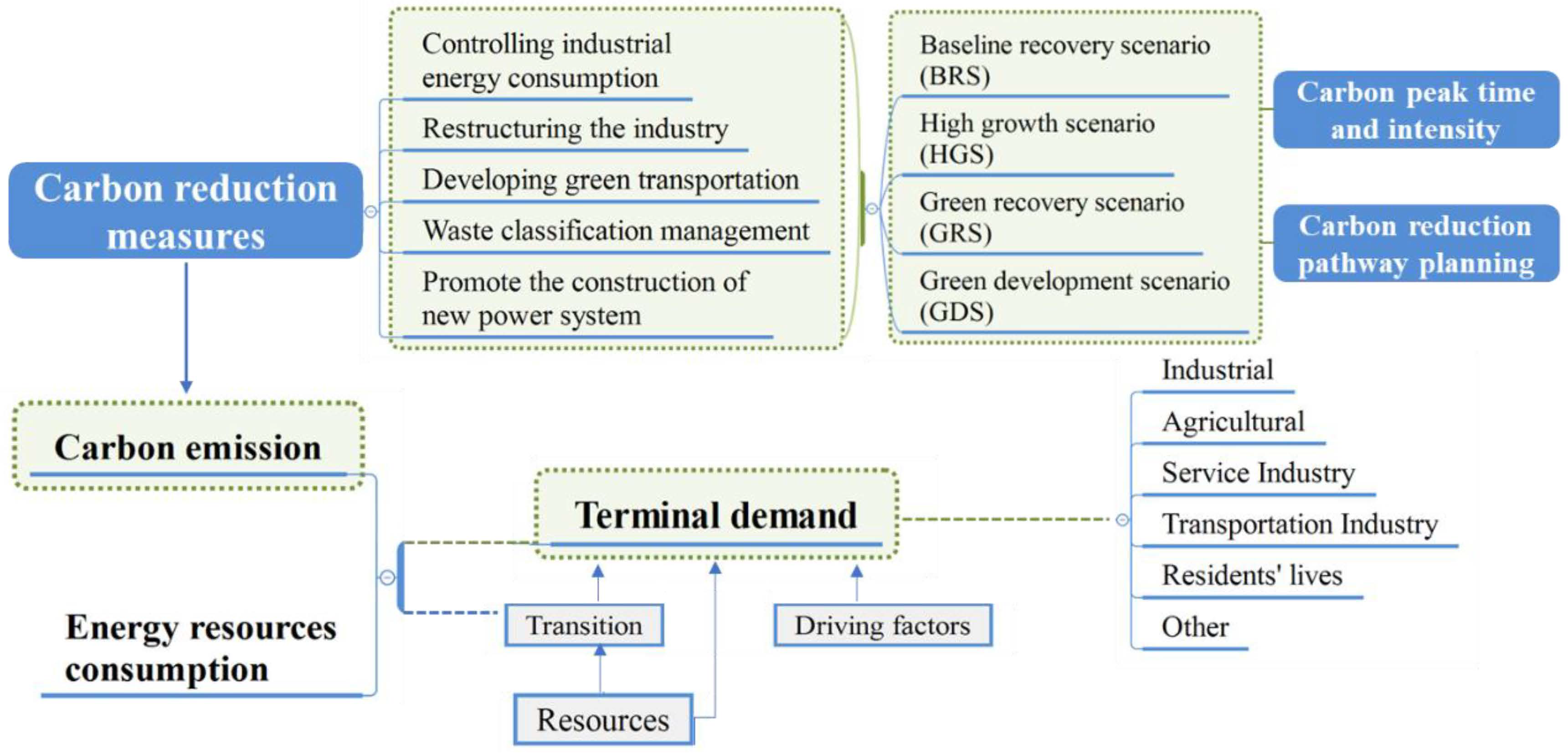
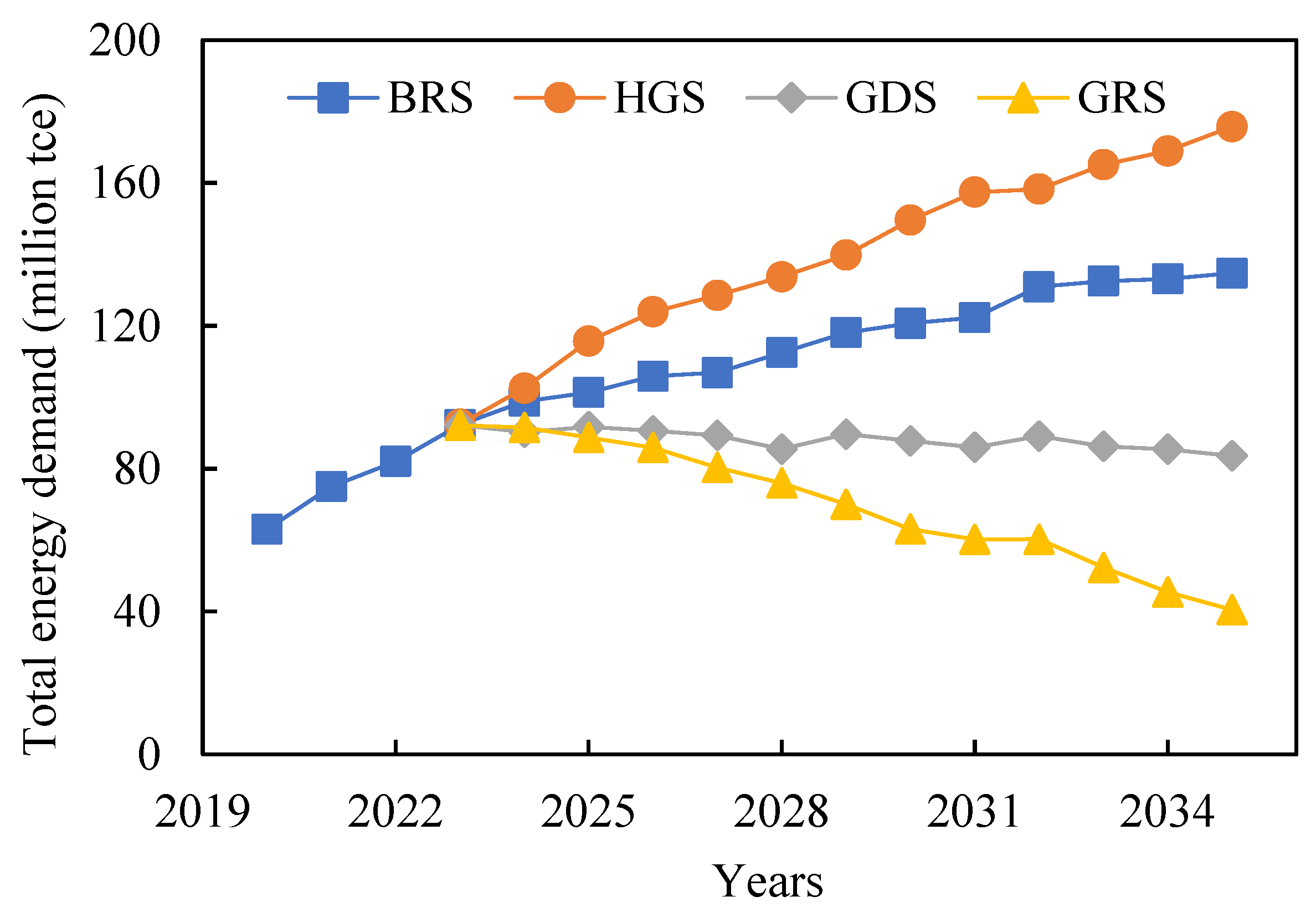
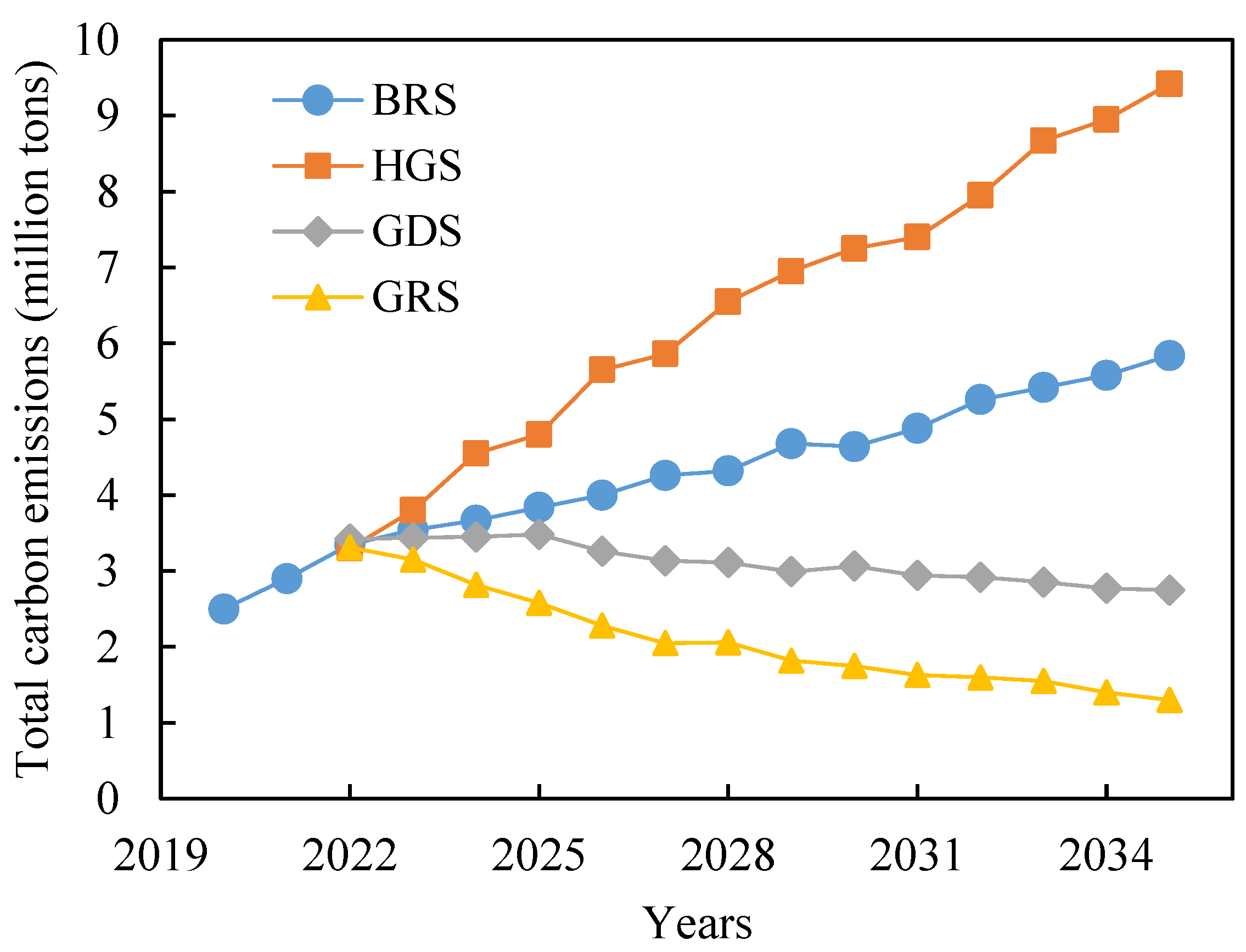
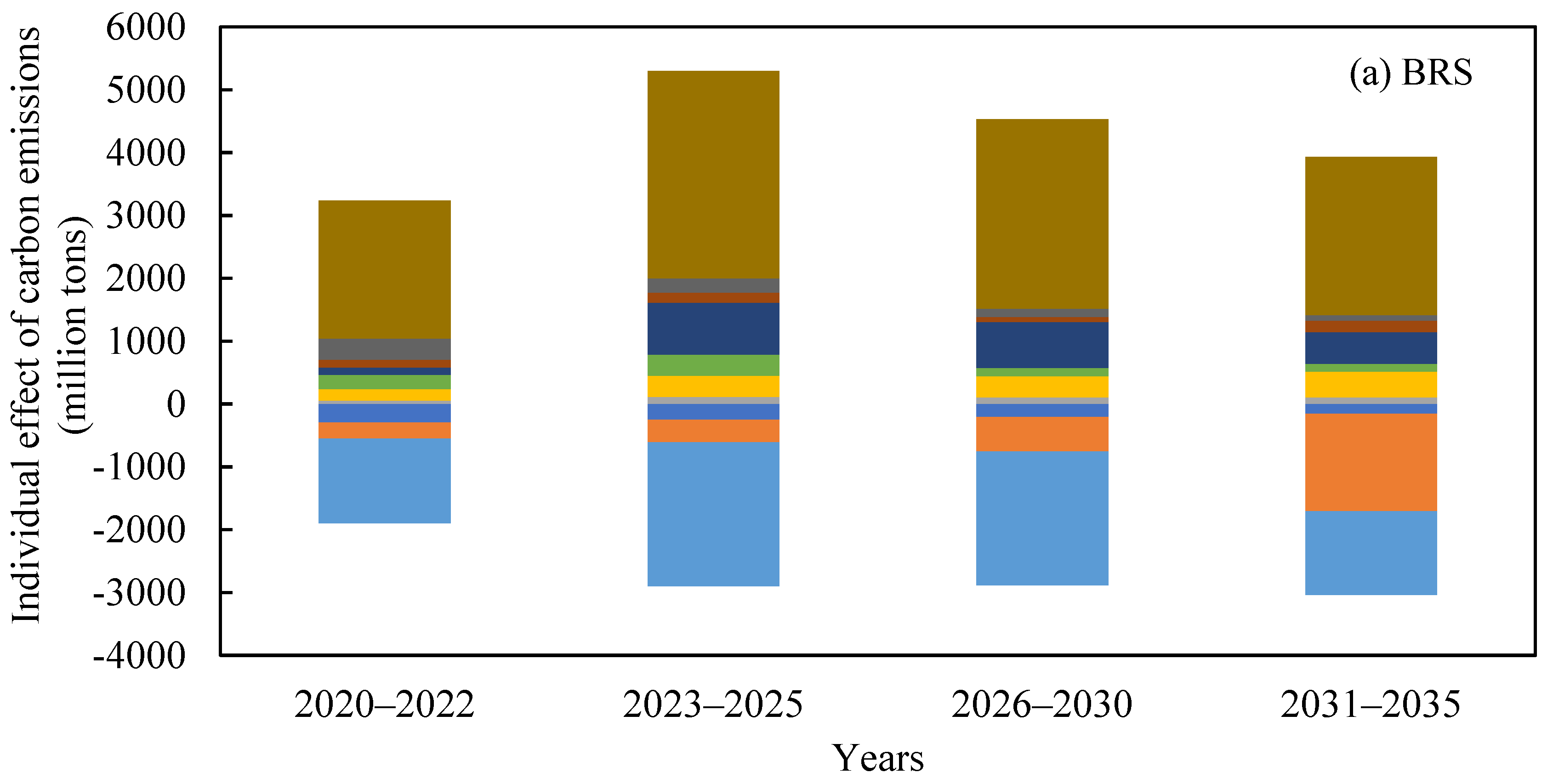
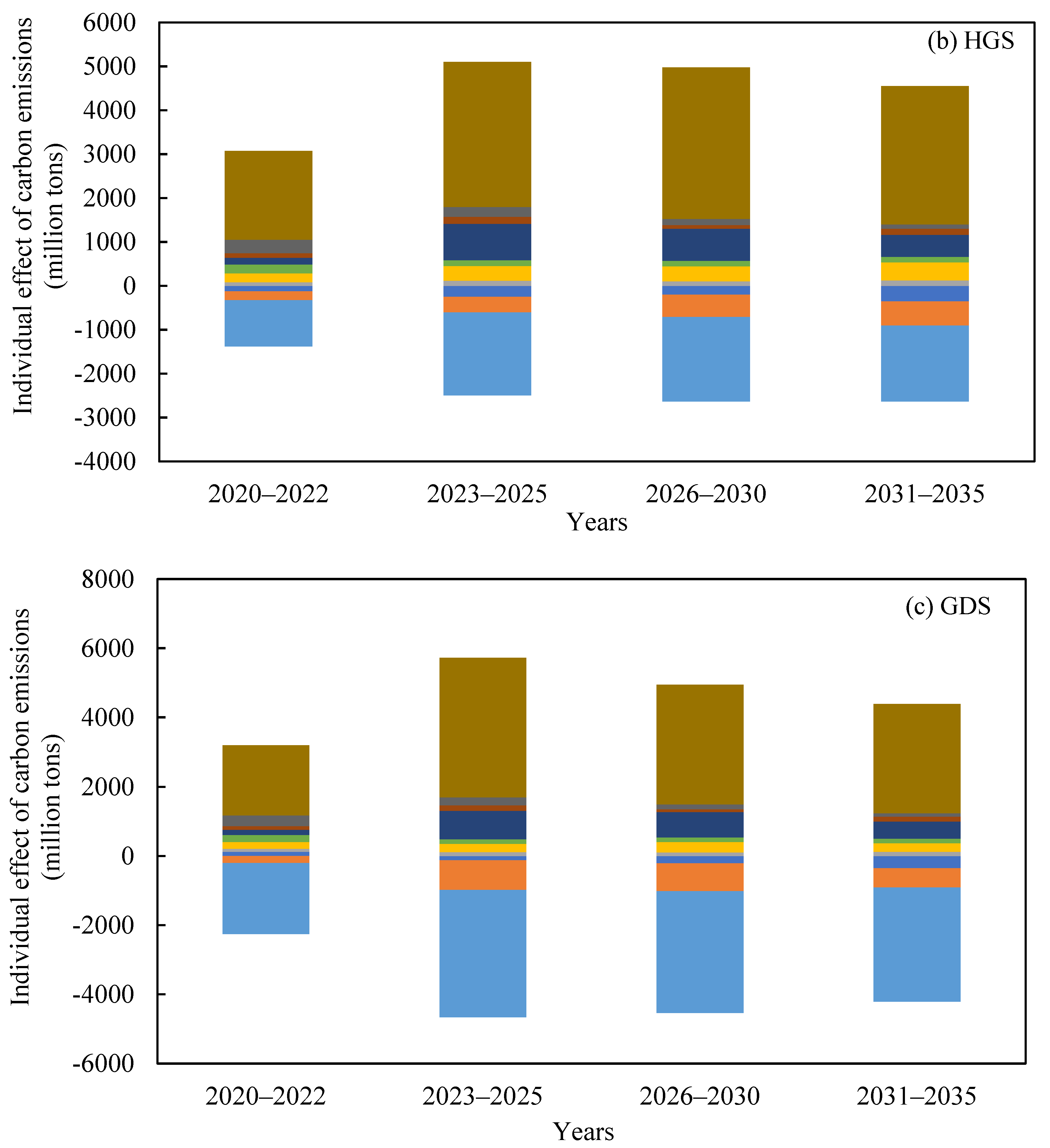
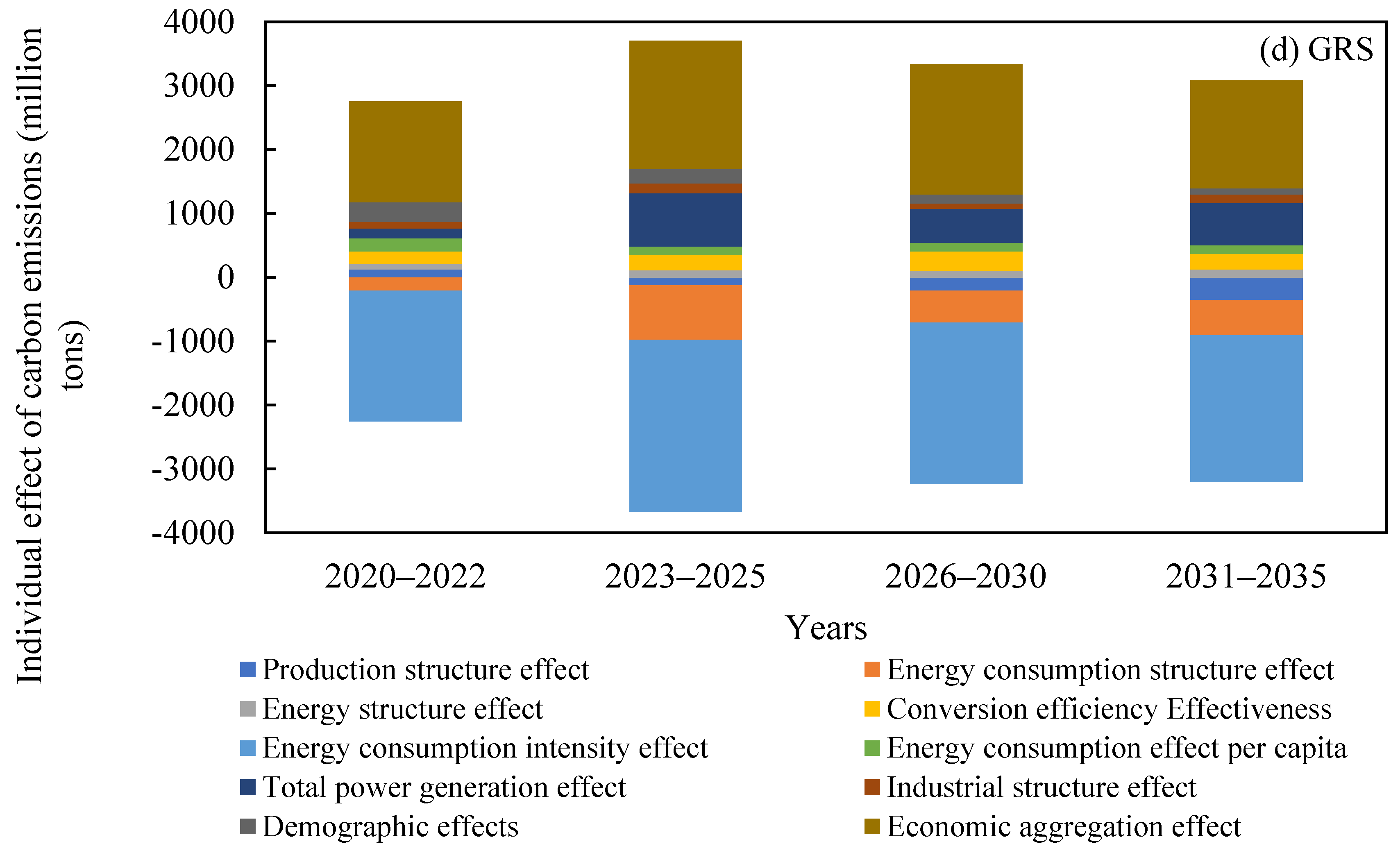
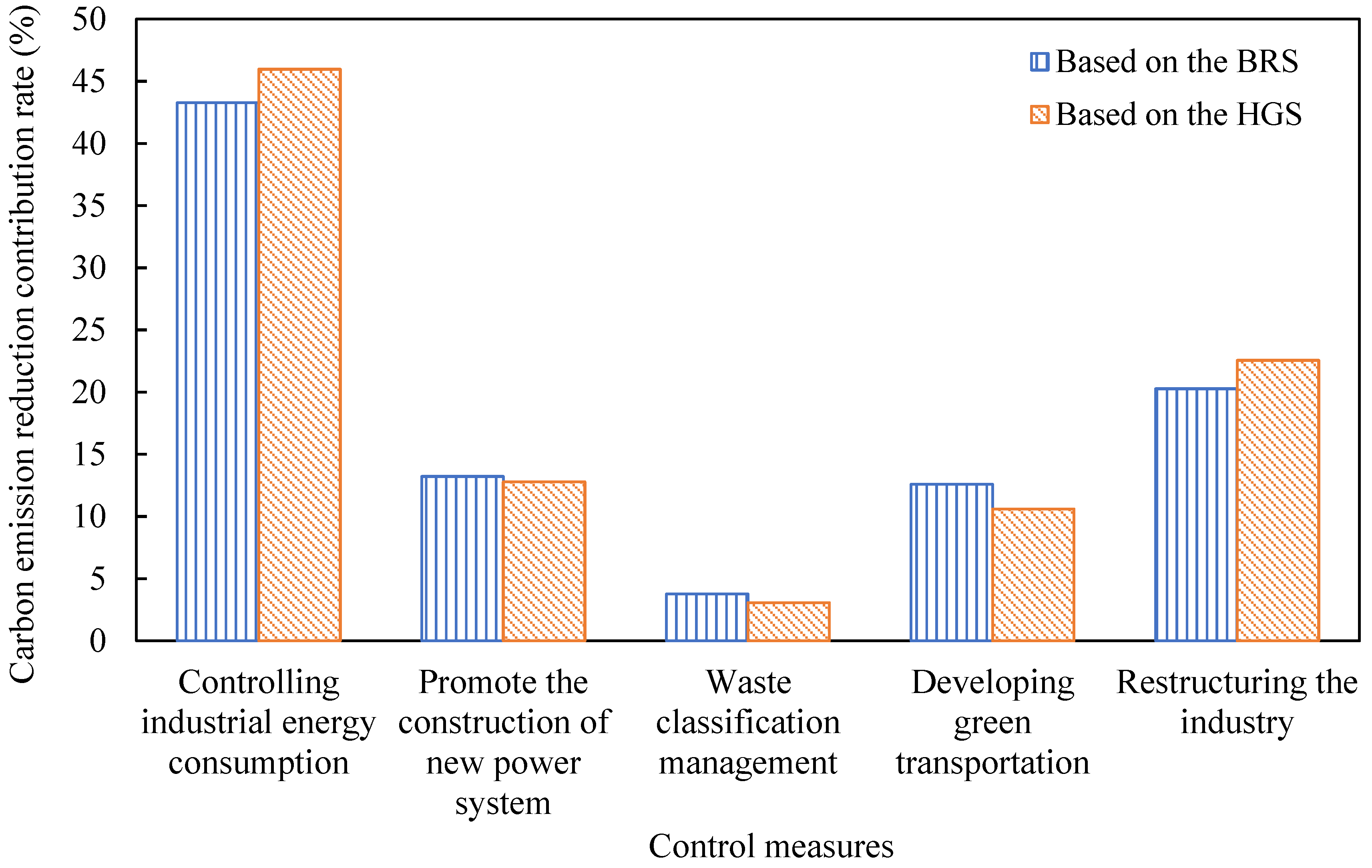
| Documents Name | Carbon Reduction Measures | Specific Objectives |
|---|---|---|
| Nanjing’s 14th Five-Year Air Pollution Prevention and Control Plan | Controlling industrial energy consumption | By 2025, the proportion of heavy chemicals will be reduced to 65%, and carbon emissions will be reduced by 29%. |
| Nanjing New Electricity System Construction Master Plan (2021–2025) | Promote the construction of a new power system | By 2025, construction of 49 major power grid construction projects in Nanjing, the installed ratio of clean energy generation will be greater than 50% |
| Nanjing’s 14th Five-Year Open Economy Development Plan | Waste classification management | By 2025, the resource utilization rate of urban household waste will be greater than 95% |
| Nanjing ‘14th Five-Year’ Major Infrastructure Construction Plan | Developing green transportation | By 2025, the green travel sharing rate in the central city will be greater than 75%, and the number of new energy vehicles will reach 300,000 |
| Nanjing’s 14th Five-Year’ Modern Service Industry Development Plan | Restructuring the industry | By 2025, the added value of the service industry will reach about 1.3 trillion yuan, and the total retail sales of consumer goods will reach 1 trillion yuan. |
| Parameters | Baseline Year | Baseline Recovery Scenario (BRS) | High Growth Scenario (HGS) | Green Development Scenario (GDS) | Green Recovery Scenario (GRS) | ||||||||||
|---|---|---|---|---|---|---|---|---|---|---|---|---|---|---|---|
| Categories | Indicators | 2020 | 2025 | 2030 | 2035 | 2025 | 2030 | 2035 | 2025 | 2030 | 2035 | 2025 | 2030 | 2035 | |
| Driving factors | Economic development | The growth rate of gross regional product (%) | 4.6 | 4.6 | 3.5 | 2.5 | 5.5 | 4.6 | 3.5 | 4.5 | 3.5 | 2.5 | 5.5 | 4.5 | 3.5 |
| Population growth | City resident population (million) | 932.5 | 1021.3 | 1082.4 | 1141.5 | 1021.2 | 1082.5 | 1141.7 | 1021.1 | 1082.3 | 1141.6 | 1021.5 | 1082.6 | 1141.8 | |
| Urbanization rate | The proportion of the urban population to the resident population (%) | 86.8 | 89.5 | 93.2 | 97.3 | 89.2 | 93.5 | 97.3 | 89.4 | 93.5 | 97.6 | 89.4 | 93.2 | 97.2 | |
| Carbon Reduction Measures | Controlling industrial energy consumption | Energy consumption of industrial added value (tce/10000 yuan) | 5.6 | 5.4 | 5.0 | 4.7 | 5.1 | 4.5 | 4.0 | 4.3 | 3.5 | 3.0 | 3.7 | 2.5 | 1.6 |
| Promote the construction of a new power system | The installed ratio of clean energy generation (%) | 22.4 | 22.6 | 23.7 | 25.8 | 22.9 | 23.2 | 25.4 | 23.6 | 23.8 | 24.4 | 27.5 | 32.4 | 38.6 | |
| Waste classification management | The resource utilization rate of urban household waste (%) | 90.2 | 90.9 | 92.45 | 93.67 | 92.2 | 93.7 | 95.2 | 94.3 | 95.6 | 96.5 | 96.3 | 97.5 | 99.5 | |
| Developing green transportation | New energy vehicle ownership (million) | 5.4 | 7.9 | 10.5 | 15.8 | 9.7 | 12.5 | 18.4 | 11.9 | 21.0 | 31.2 | 19.9 | 56.5 | 139.3 | |
| Restructuring the industry | Tertiary industry share (%) | 62.8 | 65.4 | 68.7 | 70.9 | 69.8 | 71.44 | 75.6 | 66.6 | 70.3 | 74.3 | 71.0 | 77.9 | 90.2 | |
| Years | BRS | HGS | GDS | GRS |
|---|---|---|---|---|
| 2022–2023 | 0.45 | 0.49 | 0.03 | −0.15 |
| 2023–2024 | 0.46 | 0.50 | 0.04 | −0.12 |
| 2024–2025 | 0.43 | 0.51 | 0.10 | −0.07 |
| 2025–2026 | 0.39 | 0.46 | −0.12 | −0.34 |
| 2026–2027 | 0.40 | 0.47 | −0.10 | −0.32 |
| 2027–2028 | 0.41 | 0.48 | −0.04 | −0.21 |
| 2028–2029 | 0.43 | 0.49 | −0.03 | −0.12 |
| 2029–2030 | 0.43 | 0.50 | −0.05 | −0.14 |
| 2030–2031 | 0.33 | 0.43 | −0.21 | −0.52 |
| 2031–2032 | 0.34 | 0.44 | −0.18 | −0.47 |
| 2032–2033 | 0.35 | 0.45 | −0.17 | −0.43 |
| 2033–2034 | 0.37 | 0.47 | −0.14 | −0.45 |
| 2034–2035 | 0.38 | 0.48 | −0.11 | −0.06 |
| Measures | Enhanced Single Measure Based on the BRS | Enhanced Single Measure Based on the HGS |
|---|---|---|
| Controlling industrial energy consumption | 0.8927 | 0.9253 |
| Promote the construction of a new power system | 0.1038 | 0.1271 |
| Waste classification management | 1.4522 | 1.5131 |
| Developing green transportation | 0.7089 | 0.7433 |
| Restructuring the industry | 0.1711 | 0.1805 |
Disclaimer/Publisher’s Note: The statements, opinions and data contained in all publications are solely those of the individual author(s) and contributor(s) and not of MDPI and/or the editor(s). MDPI and/or the editor(s) disclaim responsibility for any injury to people or property resulting from any ideas, methods, instructions or products referred to in the content. |
© 2023 by the authors. Licensee MDPI, Basel, Switzerland. This article is an open access article distributed under the terms and conditions of the Creative Commons Attribution (CC BY) license (https://creativecommons.org/licenses/by/4.0/).
Share and Cite
Chen, M.; Zhang, C.; Chen, C.; Li, J.; Cui, W. Main Pathways of Carbon Reduction in Cities under the Target of Carbon Peaking: A Case Study of Nanjing, China. Sustainability 2023, 15, 8917. https://doi.org/10.3390/su15118917
Chen M, Zhang C, Chen C, Li J, Cui W. Main Pathways of Carbon Reduction in Cities under the Target of Carbon Peaking: A Case Study of Nanjing, China. Sustainability. 2023; 15(11):8917. https://doi.org/10.3390/su15118917
Chicago/Turabian StyleChen, Mingyue, Chao Zhang, Chuanming Chen, Jinsheng Li, and Wenyue Cui. 2023. "Main Pathways of Carbon Reduction in Cities under the Target of Carbon Peaking: A Case Study of Nanjing, China" Sustainability 15, no. 11: 8917. https://doi.org/10.3390/su15118917
APA StyleChen, M., Zhang, C., Chen, C., Li, J., & Cui, W. (2023). Main Pathways of Carbon Reduction in Cities under the Target of Carbon Peaking: A Case Study of Nanjing, China. Sustainability, 15(11), 8917. https://doi.org/10.3390/su15118917







